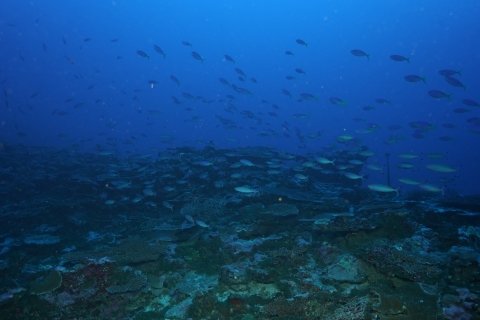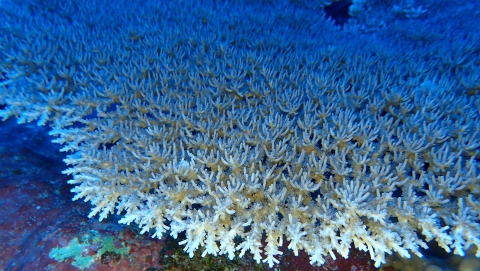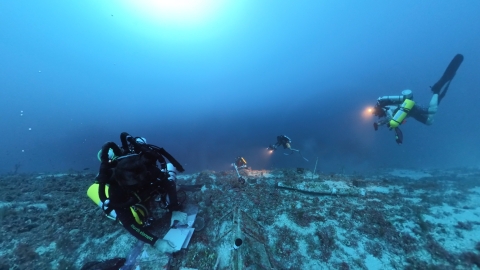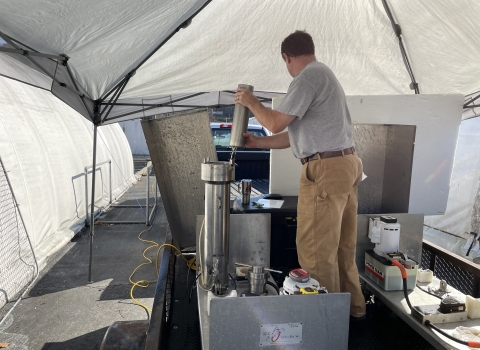The Pacific Islands are known for their shallow-water corals. Lush colors of pinks and yellows brightly adorn the shallow depths of the ocean floors. These communities’ bustle like a busy city with a variety of life from crabs and mollusks to fish and sharks. They are delicate, ecosystems balanced on the edge of a knife where a tip in either direction could be disastrous. However, meters below the hustle of these shallow-water corals lives another coralecosystem many don’t know about.
Welcome to the world of mesophotic coral ecosystems (MCEs). Found in tropical and subtropical regions of the world, MCEs are coral communities found from 30 meters (100 feet) to more than 150 meters (492 feet) deep. Existing in what many would describe as twilight, limited sunlight penetrates these depths. What makes these coral communities even more fascinating is that they are comprised of two different types of coral: nonlight-dependent corals and light-dependent corals. However, given their placement within the ocean, MCEs aren’t studied as much as shallow water corals and deep-sea corals.
Anthony “Tony” Montgomery is a marine biologist with the U.S. Fish and Wildlife Service Pacific Islands Fish and Wildlife Office in Honolulu who has a deep-sea love of corals.
“I specialize in a few things, coral reef ecology, deep-water corals, precious corals, black corals, those are the things I have an interest and expertise in,” said Montgomery. “Most of what our work entails is consultations for in-water development. So, if someone is going to build a seawall, dredge a harbor, or do some sort of modification in the waters of the United States, whether that’s fresh water or marine, there is usually a consultation requirement. We’ll do onsite surveys and assessment for what the impact might be. In development, the need for a harbor is important, but our goal is to increase the natural resources around that project.”
For his dissertation in 2016, Montgomery began a projectin Tutuila, American Samoa, to look at MCEs and how they change across depths and compared to shallow corals. Chosen for the unique bathymetry around the island, the coral banks of American Samoa extend out for a distance before making a sudden, steep drop
“Tutuila is what is called a high island, so the mountains are very tall but there is also a large bank that when the sea level used to be lower it was probably exposed and when sea level rose that all became submerged,” said Montgomery. “But a lot of that area is in this 30 to 100 meter depth zone. So when you look at the actual amount of habitat of American Samoa 79% is within the mesophotic coral ecosystem depths and only 21% are in the shallow depths. So that made me think we’re missing a huge part of this habitat, lets take a look at that.”
Montgomery’s dissertation got him invited to write a book chapter on MCEs in American Samoa, and in 2019 a grant from the National Oceanic and Atmospheric Administration (NOAA) was secured to research the MCEs in American Samoa. Unfortunately, after a team was put together and plans had been made, COVID shutdown the world.
Into the Twilight: The Mesophotic Coral Ecosystem
Imagine sitting in a park justas the sun dips over the horizon and engulfs the world around you in hues of crimson and purple. That’s what being 30 meters down looks like. Each meter that you descend deeper into the abyss is like the sun’s light dissipating into darkness across the sky. Twilight. At depth, water filters out much of the sunlight, changing the appearance of colors. Red light is the first color in the spectrum to be filtered out, followed by orange, yellow, green, then blue. Because of this light filtration, organisms, particularly light-dependent ones, tend to change their morphology or form. Shallower corals tend to have a more diverse morphology as ambient light comes from all angles. However, there is a lot less coral diversity the deeper you go as light-dependent corals grow structures that can best capture that lower light.
“A finger coral can capture light from any direction,” said Montgomery. “But the deeper you go that light is getting more filtered and more directional, so what you’re getting are corals that are more plate or cup-like to capture that directional light that is coming down.”
Underwater currents also play a large role in the formulation of these corals. Shallow waters have varying surges, water motion that goes back and forth with every wave. Deeper waters don’t have the same varying water motions as underwater current directions switch every six hours with the tide. This consistent shift of currents has resulted in coral adaptations that gather food from the water rather than depend on the limited light.
“Every six or so hours, currents might switch 180 degrees,” said Montgomery.“Maybe they're stronger one direction or the other, but you're getting a dramatic change in water flow. And when you do that in a lower light environment, you actually get the presence of all these other types of corals that are not light dependent. You get black corals, or gorgonians that grow like trees or sea fans that don’t need light but they’re efficient at gathering food out of the water, so those currents are very important.”
The Importance of Mesophotic Coral Ecosystems
Since the invention of scuba, exploration of the world’s reefs has grown extensively, but mostly limited to the upper 30 meters. Underwater exploration can be made easier with the help of submersibles and remotely operated vehicles, but research with these technologies is expensive, hard to get in remote locations, and typically go to areas that are deep within the ocean’s void.
“If you have hundreds of thousands of dollars you want to throw at a project, you’re probably not going to 40 or 50 meters,” said Montgomery. “Most of the time people want to go to 500 meters, 1000 meters, 1200 meters. They want to go deep because there's no other way to get down there. And so, there's this zone between 30 to 150 meters depth that just gets overlooked. From a lot of dredge studies and people pushing the boundaries of recreational scuba limits, we kind of know there are these ecosystems down there. Over time we would find these hot spots of high-density corals at depths where most people didn’t think light-dependent corals would grow. So, there’s this huge void of basic information of where are these ecosystems or what are the species and communities that are there. Because of this void of information there have been some hypotheses that have been tossed about.”
One of those hypotheses was the Deep Reef Refuge Hypothesis which lends itself to the idea that MCEs could be a refuge to replenish shallow-water corals impacted by climate change climate change
Climate change includes both global warming driven by human-induced emissions of greenhouse gases and the resulting large-scale shifts in weather patterns. Though there have been previous periods of climatic change, since the mid-20th century humans have had an unprecedented impact on Earth's climate system and caused change on a global scale.
Learn more about climate change and coral bleaching. However, new evidence suggest that corals found in the MCE are unique communities that share only a few overlapping species with shallow waters.
Since this discovery, there has been a shift to focus on these distinct mesophotic communities that science doesn’t quite understand. It has gone from the thought of a shallow-water coral refuge to a study of unique biodiverse ecosystems, how to protect them, and determining the crossroad between overlapping shallow-water communities versus distinctly different communities.
“The more we look for threats in deep-water corals we’re finding these are just as threatened as shallow waters (corals), just in different ways,” said Montgomery. “If we don’t start to look at these mesophotic coral ecosystems and understand them better, we can start to lose communities that we didn’t even know existed. That's why they're important. They're understudied. They’re unique. And they still might have an overlap with shallow reefs.”
Potential Threats to the Mesophotic Coral Ecosystems
Increasing ocean temperatures caused by climate change, over exposure to ultraviolet light, and other stressors all play a role in coral bleaching. The original thought is that thermal change in shallow waters can be a lot higher than in deeper waters. The deeper you go in the ocean the cooler it gets because there’s thermal protection and lower exposure to light. While there is still some truth to this, scientists are discovering high temperatures in shallow waters can go down deeper then previously thought. And for them the concern is that these corals are adapted to a more stable temperature profile and therefore more susceptible to bleaching.
“Maybe the thermal change in deeper water is not as high as in shallow water, but it's still higher than what those corals have been adapted to,” said Montgomery. “And so, there's still a risk of corals being threatened by bleaching. Part of this project will look at what those bleaching thresholds are across shallow corals and mesophotic corals, which is something Dan Barshis from Old Dominion University specializes in. We'll monitor which corals cross between depths and which corals are specialized at their depths, and try to better understand what their bleaching resilience is or what threats there are at these depths.”
The Project Continues...
Montgomery and the rest of the Deep Coral Reef Ecosystem Studies (Deep-CRES) Program team were finally able to begin their MCE field research in January of 2023 after several years of COVID delays including the closure of American Samoa to all travelers. Funded by NOAA's National Center for Coastal Ocean Science, the Deep-CRES team is comprised of Ken Longenecker, Richard Pyle, and Brian Greene from the Bishop Museum Center for teh Exploration of Coral Ecosystems, Rob Toonen from the University of Hawaiʻi at Mānoa Hawaiʻi Institute of Marine Biology, Randy Kosaki from Papahānaumokuākea Marine National Monument, and Dan Barshis from Old Dominion University.
Each member of the Deep-CRES Program team also has a different and important role to play. Longenecker, Pyle, and Greene are researching individual species of fish and seeing what their reproductive characteristics are in deeper water versus shallow water. Toonen's focus is on environmental DNA and metabarcoding for some invertebrate communities. Kosaki is researching fish communities and looking at biomass. Barshis is studying bleaching resilience of these corals. And Montgomery's focus is looking at the coral recruitment and coral species assemblages. The Deep-CRES Program team is also characterizing the water quality by setting up sensors for measurements.
This project will also take a closer look at marine cryptobiota, cryptic invertebrates that serve as building blocks for coral. Because these invertebrates are hard to find and collect, the team set out plates that will be left out for varying times during this four year project. This will allow the Deep-CRES Program team to describe the invertebrate communities that have settled and are growing at the mesophotic depths.
“A lot of times when people do research on mesophotic coral ecosystems, they look only at corals and fish,” said Montgomery. “A lot of the algae and invertebrates tend to get overlooked. We want to have that broader overview of the ecosystem. Yes, we’re looking at coral, and yes, we are looking at fish, but we’re also trying to put a lot of emphasis on algae and invertebrates because these are equally, and in some cases, a bigger part of these ecosystems. We’re finding that the number of new species found are going to be a lot higher in these invertebrate or algal communities because even in shallow water we don't know these species as well as fish and corals.”
Long overlooked, the twilight realms of our oceans are remain a mystery. Their inhabitants have adapted to extreme conditions that exist between the world of light and dark. With a little more than a year into this project’s field work, the Deep-CRES Program team has made several trips back to the MCEs of American Samoa to collect data and maintain the equipment they’re using to collect that data. While still in its infancy, the Deep-CRES Program team are hopeful that after this project is through, they will have a greater understanding of not just MCEs in American Samoa, but all coral ecosystems. Until then, the mysteries of these MCEs are as clear as twilight.






